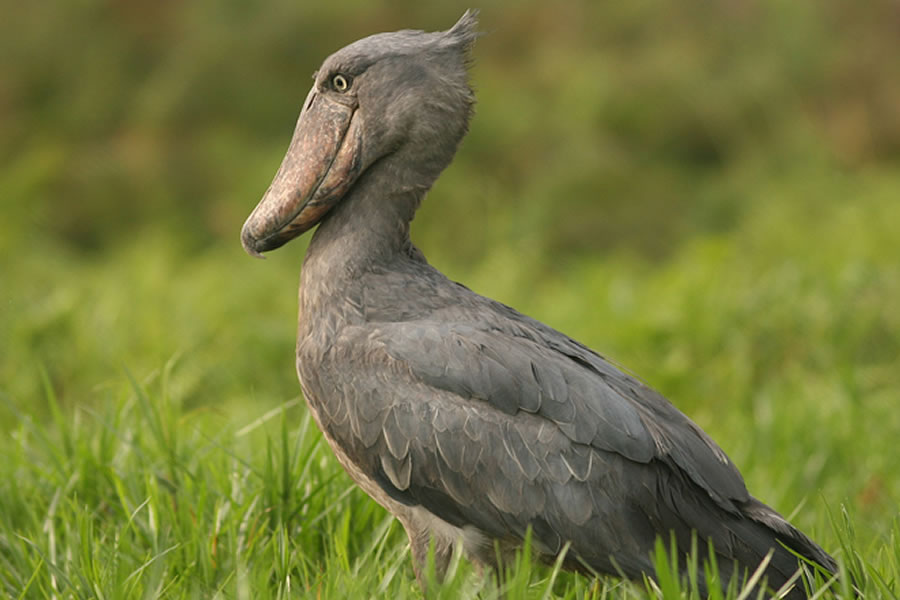Embark on an African adventure like never before as we unveil the top 7 best…

The Shoebill facts

The Shoebill facts: The term of Shoebill serves as the most frequently used of the common names for a stork-like bird, renowned for its size. It also has alternate names by which it’s known, though. These include the whale head, whale-headed stork, and shoe-billed stork. In this article , we are going to talk about The Shoebill facts . It might look a little unreal but there is a healthy number of shoebills in Uganda that you can meet during Uganda safaris.
The Shoebill facts: Distribution & Natural Habitat
The Shoebill has a somewhat limited range of habitation. That’s due to the fact that it only appears to live in a small portion of one continent. Evidence indicates it once had a greater range, though. It tends to inhabit around freshwater swamps, wetlands and marshlands.
The Shoebill facts: Can a shoebill fly
Yes, shoebills fly but not very far or and they seem to be big, but they can fly if they want to.
They make sounds similar to machine guns
Although they do have some vocal calls and cries that they use to communicate with each other, shoebills tend to make a clattering sound with their large beaks that is described as sounding like a machine gun being fired. This can be extremely startling to hear in the middle of the wilderness.
The Shoebill facts: Where to find shoebill
The Shoebill is endemic to East and Central African, countries of Uganda, DRC, Kenya, Botswana, Tanzania, Ethiopia, Zambia and South Sudan. In Uganda, you can see these rare birds in Mabamba swamp, Lake Mburo National Park, Zziwa Rhino Sanctuary, and Murchison Falls National Park.
Shoebill Physical Description
Unlike other bird species, shoebill is a tall bird. Its great physical size, though, easily ranks as one of these distinguishing traits. That’s because it’s a tall bird, to put it mildly. That’s due to the fact that mature adults stand an average of 43 – 55 in (110 – 140 cm) in height. Exceptional specimens reach 60 in (152 cm).
It is grey in color, but the most outstanding feature is the shoe-shaped bill.

The beak of the shoebill is curved at the tip and has very sharp edges with which the bird uses to cut through its food. The beak is almost 10 inches long, deadly and used for both feeding and protecting itself.
The legs are long, slender and black in color, with large feet.
The shoebill wings can spread up to 2.5 meters (8 feet) and can flap about 150 times per minute. This means that when a shoebill spreads its wings, it has a bigger wingspan than Shaquille O’Neal (Wingspan of 7.5 feet). That is how massive a shoebill really is.
Although it is called a shoebill stork, it is a member of the taxonomic order of Pelecaniformes. These are a family of medium to large-sized water birds. This means they are more closely related to the pelicans, anhingas and gannets than to the storks.
The Shoebill facts: Social Habits
Socially, the shoebill is a solitary and quiet animal. Partners only come together for mating, building the nesting area and incubating the eggs. The shoebill stork can live for more than 35 years in the wild. A shoebill stork becomes sexually active at 3 to 4 years of age.
The Shoebill facts: what is the incubation period of Shoebill
The shoebill mating season is closer to the dry period than the wet period when it is safer for the nest and eggs. The female lays between 1 to 3 eggs and incubates them for about 30 days until they hatch.
The young one is not able to stand and move on its own until two months later, so it solely depends on the mother’s food provision until three months later when they can do this on their own with the supervision of the parents. When hungry the chicks make hiccup-like sounds to notify the mother that they need food.
The chicks are known for being insanely competitive. It is the real survival for the fittest in the shoebill’s nest. They fight each other off until the weakest chick is pushed out. The bigger chicks often pick on the smaller ones especially when the mother is way, and this often drives the defeated bird to live outside of the family. Sibling rivalry is very common among these young shoebills.
It is a quiet animal and can go for days without making any noise or sounds leave for the flapping of its wings. However, when it does make a sound it is indeed ground shaking. This is most evidenced in the mating season when the male adult picks out its mate. It will make a resounding clapping-like sound attracting the said female while simultaneously scaring away any competitors and other small animals. The male and female bow to each other as a display of their courtship.
The shoebill can fly but not for a long period of time considering it can only flap its wings 150 times a minute (Slowest rate of any bird). It can only fly up to 500 meters.
A shoebill spends most of the time standing, hidden and watching out for its prey. It is said that a shoebill can stand motionless for hours while holding their bills close to their necks. Such a meditative and yet cunning hunter.
The shoebill’s wings are usually used for balance
Since the shoebill has very long legs and since it lives a lot of its live standing on plant life floating in swamps, it usually uses its wings for balance rather than for anything else. The long wingspan of the shoebill helps it stay upright without tipping over when walking on swampy vegetation, and this, in turn, makes it easier to hunt for their favorite fish.
What do shoebills eat?
Shoebills, which live in the swamps of eastern tropical Africa, They eat big fish like lungfish, eels, and catfish, and also crazy stuff like Nile monitor lizards, snakes, and baby crocodiles. This bird eats crocodiles!

Can a shoebill be a pet?
Shoebills are quite large, which makes it a bit difficult to keep them in house. In most places it is illegal to own a shoebill stork as a pet, and they are threatened with extinction, which makes each individual important for the survival of the species.
How strong is a shoebills beak?
The shoebill stands at an average height of four and a half feet. Its massive seven-inch beak is strong enough to decapitate a six-foot lungfish, so it’s no wonder why this bird is frequently compared to a dinosaur.
Where do Shoebills nests are built
Shoebills don’t like to nest in trees or directly on the ground. Instead, they prefer to stay in the water where their food is located. However, they still need a place to lay their eggs. For this reason, shoebills tend to nest on dense vegetation floating on the surface of swamps and marshes.
Conservation Status
The available data indicate that the population of the shoebill is decreasing.
The population of shoebills is estimated to be around 5000 in the entire world. Although, it is hard to have the exact number of living shoebills because of their mysterious and elusive nature. They set up nests in hard to reach areas for humans.
The biggest threat to this interesting bird is humans. The constant encroachment on wetlands for human economic activity is a continuous threat to these birds.
There are also certain myths and superstitions about the shoebill that lead to it’s hunting. A common myth is that shoebills on the shores of the river/lake bring bad luck to the fishermen for the day.
In Uganda, they are estimated to be less than 1,000 shoebill birds left.
The shoebill is an interesting bird to watch during your Uganda safaris in Mabamba swamp, Lake Mburo National Park, Zziwa Rhino Sanctuary, and Murchison Falls National Park.



